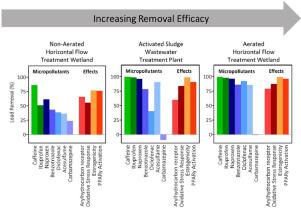Water Research ( IF 11.4 ) Pub Date : 2021-06-12 , DOI: 10.1016/j.watres.2021.117349 Nadine A Sossalla 1 , Jaime Nivala 2 , Thorsten Reemtsma 3 , Rita Schlichting 4 , Maria König 4 , Nicolas Forquet 2 , Manfred van Afferden 5 , Roland A Müller 5 , Beate I Escher 6

|
Seven treatment wetlands and a municipal wastewater treatment plant (WWTP) were weekly monitored over the course of one year for removal of conventional wastewater parameters, selected micropollutants (caffeine, ibuprofen, naproxen, benzotriazole, diclofenac, acesulfame, and carbamazepine) and biological effects. The treatment wetland designs investigated include a horizontal subsurface flow (HF) wetland and a variety of wetlands with intensification (aeration, two-stages, or reciprocating flow). Complementary to the common approach of analyzing individual chemicals, in vitro bioassays can detect the toxicity of a mixture of known and unknown components given in a water sample. A panel of five in vitro cell-based reporter gene bioassays was selected to cover environmentally relevant endpoints (AhR: indicative of activation of the aryl hydrocarbon receptor; PPARγ: binding to the peroxisome proliferator-activated receptor gamma; ERα: activation of the estrogen receptor alpha; GR: activation of the glucocorticoid receptor; oxidative stress response). While carbamazepine was persistent in the intensified treatment wetlands, mean monthly mass removal of up to 51% was achieved in the HF wetland. The two-stage wetland system showed highest removal efficacy for all biological effects (91% to >99%). The removal efficacy for biological effects ranged from 56% to 77% for the HF wetland and 60% to 99% for the WWTP. Bioanalytical equivalent concentrations (BEQs) for AhR, PPARγ, and oxidative stress response were often below the recommended effect-based trigger (EBT) values for surface water, indicating the great benefit for using nature-based solutions for water treatment. Intensified treatment wetlands remove both individual micropollutants and mixture effects more efficiently than conventional (non-aerated) HF wetlands, and in some cases, the WWTP.
中文翻译:

通过常规和强化人工湿地处理城市污水去除微污染物和生物效应
在一年的时间里,每周对七个湿地处理厂和一个市政污水处理厂 (WWTP) 进行监测,以去除常规废水参数、选定的微污染物(咖啡因、布洛芬、萘普生、苯并三唑、双氯芬酸、安赛蜜和卡马西平)和生物效应。研究的处理湿地设计包括水平地下流 (HF) 湿地和各种强化湿地(曝气、两级或往复流)。作为分析单个化学品的常用方法的补充,体外生物测定可以检测水样中已知和未知成分的混合物的毒性。选择了一组五个基于体外细胞的报告基因生物测定来涵盖环境相关终点(AhR:指示芳烃受体的活化;PPARγ:与过氧化物酶体增殖物激活受体γ结合;ERα:雌激素受体α的激活;GR:糖皮质激素受体的激活;氧化应激反应)。虽然卡马西平在强化处理湿地中持续存在,但在 HF 湿地中实现了高达 51% 的月平均质量去除。两级湿地系统对所有生物效应显示出最高的去除效率(91% 至 >99%)。HF 湿地的生物效应去除效率为 56% 至 77%,污水处理厂为 60% 至 99%。AhR、PPARγ 和氧化应激反应的生物分析等效浓度 (BEQ) 通常低于推荐的地表水基于效应的触发 (EBT) 值,表明使用基于自然的解决方案进行水处理的巨大好处。强化处理湿地比传统(非曝气)HF 湿地,在某些情况下,比污水处理厂更有效地去除单个微污染物和混合物效应。











































 京公网安备 11010802027423号
京公网安备 11010802027423号